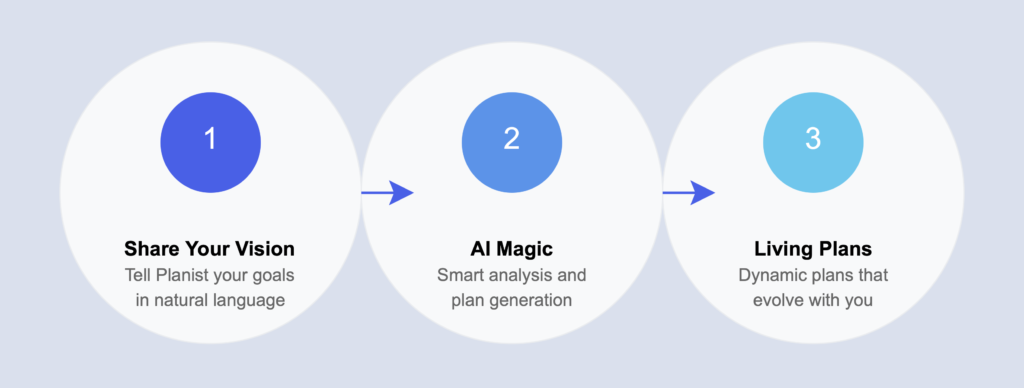How Planist Works
Planist revolutionizes how you approach planning by combining advanced AI technology with an intuitive, human-centered design. Our platform understands your needs, adapts to your style, and grows with your ambitions.

Share Your Vision Simply tell Planist what you want to achieve in your own words. No need for complex project management jargon – our system understands natural language, just like talking to a skilled planning assistant. Whether you’re organizing a small project or mapping out your company’s future, Planist listens and understands.
Smart Analysis & Plan Creation Our advanced AI engine processes your input, considering countless variables and possibilities. It draws from successful planning patterns, your previous experiences, and real-world data to craft optimal plans. The system accounts for your resources, time constraints, and even energy levels to create realistic, achievable plans.
Living Plans That Evolve Unlike traditional static plans, Planist creates dynamic roadmaps that adapt to change. As circumstances shift, your plans automatically adjust. The system learns from your progress, suggests improvements, and helps keep everyone aligned. It’s like having a skilled project manager working 24/7 to keep your plans on track.
Seamless Collaboration Share your plans with team members, stakeholders, or clients with just a click. Everyone stays updated in real-time, and changes are synchronized instantly. Planist’s intelligent system manages conflicts and ensures smooth collaboration, whether you’re working with a small team or a large organization.
Marketplace of Ideas Tap into our growing community of planners. Discover and adapt successful planning templates from similar projects, or share your own winning strategies. The Planist marketplace is where great ideas meet practical implementation, helping everyone plan smarter.

Structure of Planist: Technical Architecture Deep Dive
- AI-Driven Planning Engine Overview
- Core Architecture:
- Microservices-based architecture using Node.js and Express.js
- TensorFlow and PyTorch integration for deep learning capabilities
- LSTM networks for sequential task processing
- Deep Q-Network (DQN) for plan optimization
- Kubernetes orchestration for scalable deployment
- Natural Language Processing Capabilities
- Technical Stack:
- Integration with GPT-3 API for advanced language understanding
- Custom BERT model for domain-specific planning language
- Real-time processing pipeline using Apache Kafka
- Context-aware processing for understanding user intent
- Multi-language support through translation APIs
- Adaptive Planning Methodology
- Implementation:
- Event-driven architecture for real-time updates
- MongoDB for flexible plan schema storage
- Redis caching for performance optimization
- Machine learning pipeline for continuous improvement
- WebSocket implementation for live updates
- Collaboration Features
- Technical Components:
- Socket.io for real-time collaboration
- Conflict resolution system using operational transformation
- Redis pub/sub for event broadcasting
- JWT-based authentication system
- Role-based access control (RBAC)
- Plan Marketplace Infrastructure
- Core Components:
- PostgreSQL for transactional data
- Elasticsearch for plan template search
- Content delivery network (CDN) integration
- Payment gateway integration
- Rating and review system
Data Flow Process:
- User input is received through the frontend applications
- API Gateway authenticates and routes requests
- Natural Language Processing engine interprets user intent
- AI Planning Engine generates or modifies plans
- Data is stored across distributed databases
- Real-time updates are pushed to connected clients

Key Technical Features:
- Horizontal scalability through microservices
- High availability through redundancy
- Real-time processing and updates
- Secure data encryption at rest and in transit
- Performance optimization through caching
- Automated backup and recovery systems
The architecture is designed to be:
- Scalable: Handles growing user base and data volume
- Resilient: Maintains operation during partial failures
- Secure: Implements multiple security layers
- Performant: Optimized for real-time operations
- Maintainable: Modular design for easy updates

